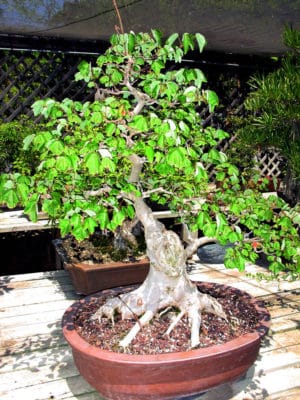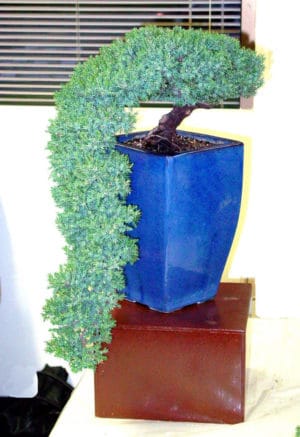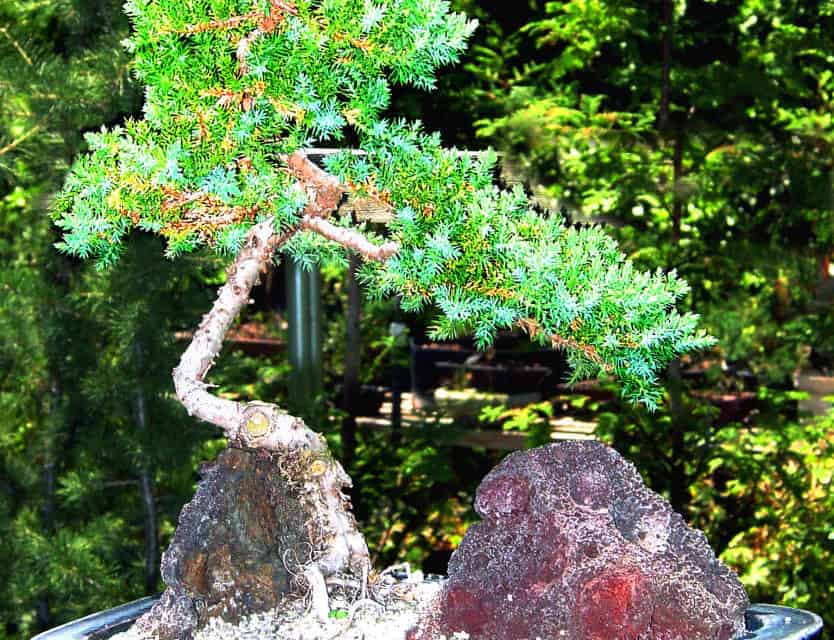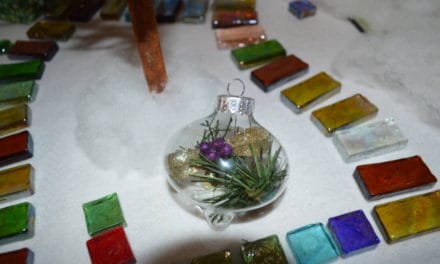Bonsai!
Story and photos by Stacy Fisher
Tiny Trees, magnificently
Nurtured and disciplined;
Dramatic swirls of
Outstretched limbs;
Living enduring poetry.
—Khan Komai

Bonsai is a hobby that is growing in popularity worldwide. For professional growers, bonsai can provide a modest living as well.
The philosophy behind bonsai is that mankind’s attitude towards nature should not be to conquer, but rather to act as good stewards of the earth, appreciating her natural gifts of life, harmony and beauty.
Bonsai actually dates back to ancient China, according to information on the Internet. During the Han Dynasty (206 B.C. – 220 A.D.) an emperor created a Lilliputian landscape encompassing miniature hills and valleys, along with running rivers, lakes, and tiny trees that represented his entire kingdom, which he could gaze upon from his palace window.
The Japanese were the first to bring the art of bonsai to America in the early 20th Century.
For the past 21 years, Pat Gilmore has been a proud member of the Chico Bonsai Society in Butte County, and until recently was treasurer for the past 12 years. Roberta Walters, who remains an active member, founded the Society in 1976. Some participants have joined recently, while others have been with the organization long term.
“The number of people who are members goes up and down over the years, with presently 10 active members,” states Pat. “We meet roughly once a month between September and May, and just moved to a new location for our regular meetings at the Chico Library on 1st Av. in Chico.”
Members include people from all walks of life, and range in age from high school students to seasoned citizens.
Every branch and twig of a bonsai is shaped or eliminated until the chosen shape is achieved, Pat says. The tree is maintained and improved by a regime of trimming according to prescribed procedures. Bonsai grows and develops during a narrow season from spring through summer, and its tending must be carefully implemented.
Members share tips on the growing of bonsai and distribute instructional resources. “Sometimes we’ll have workshops on a particular species of tree. Occasionally we’ll host guest lecturers to lead the group in some aspect of the hobby.”
People can start acquiring plants from nursery stock, from other bonsai growers, collecting from landscaping sources, or from the wild. You can actually get permits from the forest service to collect trees from federal lands.
“Some of the collected bonsai trees are two or three hundred years old,” but are no more than a foot or so high, he says. People have one or two trees that they work on in class, while others may have up to a couple of hundred in their collection.
It can be an expensive hobby, but it doesn’t have to be. It depends on how far one wishes to take it. “A beginner doesn’t need to invest that much to start,” Pat assures those who are considering the craft. “You can start with nursery stock that doesn’t cost very much, or choose expensive plants that are already well established in their form.”

Basic tools like small clippers are more than adequate to start the process, and later practitioners can graduate to more expensive bonsai tools because they are very specialized in their function.
Before starting your bonsai garden, scan the Internet or your local library on the subject to find information on successfully raising your bonsai collection or for a list of nurseries and suppliers.
Bonsai is a living sculpture that people can create into something wonderful. Serious practitioners of the art spend years and even decades on their individual trees. Overall, bonsai is a great hobby — or even profession — for anyone to undertake. A well-tended bonsai garden is most definitely a horticultural masterpiece.
Everyone mostly does it for the love of it. “The hobby attracts people because it is something of a meditative hobby in a lot of ways. You can lose yourself in it. It’s a great diversion from the stresses of life.”
The Society is open to anyone with an interest in bonsai. People can come to attend meetings to see what the organization is all about. “They’re always welcome,” Pat remarks.
Once a year they have their spring show, which is usually around the last weekend in April or the first weekend in May. “It’s our opportunity to showoff what we’ve been working on during the year.”
Chico Bonsai Society regularly meets at the Chico Library on 1st Av. in Chico, CA. For more information, contact Treasurer Chuck Coate at: 831-262-6441 or 530-899-9534; Times of meetings may vary every month. There is a small annual membership fee. Additional information: Pat Gilmore (530) 891-5466 or (530) 343-3447.












